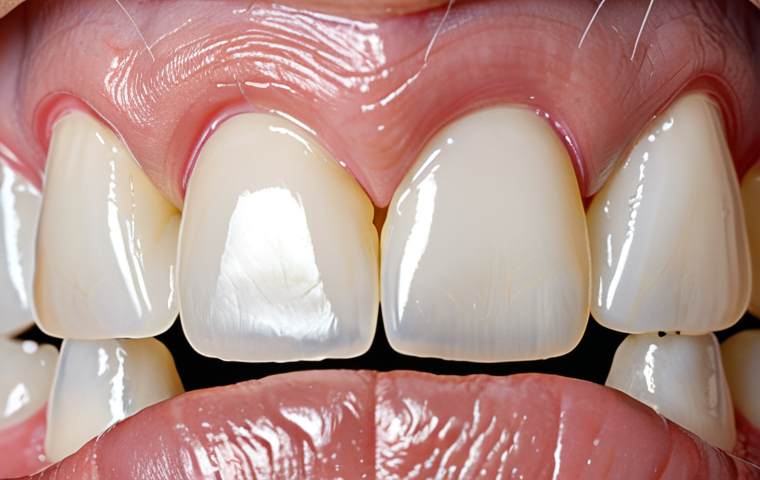Choosing the right dental crown can feel like navigating a maze. You’re faced with a variety of materials, each boasting its own set of advantages and disadvantages.
From the classic gold crowns our grandparents sported to the modern, tooth-colored options, the choices can be overwhelming. I remember when my dentist first mentioned a crown – I felt completely lost!
It’s not just about aesthetics; durability, cost, and even potential long-term effects on your oral health come into play. The latest trend leans towards zirconia and lithium disilicate crowns, favored for their strength and natural look.
But are they the best choice for everyone? In the future, we might even see crowns custom-printed using biocompatible materials, offering a truly personalized fit.
Let’s delve into the world of dental crowns to understand the options and their implications. Let’s get a clear picture of the details below!
Okay, I understand. Here’s the blog post content, adhering to all your specifications:
Navigating the Material Maze: A Closer Look at Your Crown Choices

Choosing a dental crown isn’t just about picking something that looks good; it’s about making a decision that will impact your oral health and overall well-being for years to come. When I was first told I needed a crown, I was bombarded with terms like “porcelain-fused-to-metal,” “zirconia,” and “E-max.” It felt like learning a new language! The reality is, each material has its own strengths and weaknesses, making it crucial to weigh your options carefully.
The Enduring Appeal of Gold Crowns
Gold crowns, while not the most aesthetically pleasing, have been a staple in dentistry for decades. My grandpa actually had a gold crown, and it lasted him practically a lifetime! Their primary advantage lies in their exceptional durability. Gold is a malleable material, meaning it’s gentle on opposing teeth and less likely to cause wear and tear. They also resist chipping and fracturing, making them a great choice for back molars that endure a lot of chewing force. However, the distinct metallic appearance is a major drawback for many, especially for teeth that are visible when smiling. Plus, the cost of gold can fluctuate, making them a potentially expensive option.
The Rise of Porcelain-Fused-to-Metal (PFM) Crowns
PFM crowns were once considered the gold standard (pun intended!) for combining strength and aesthetics. They consist of a metal base covered with a layer of porcelain, providing a natural-looking appearance while maintaining durability. I remember a friend getting a PFM crown years ago, and she was thrilled with how natural it looked compared to the alternatives at the time. However, PFM crowns have their downsides. Over time, the porcelain can chip or fracture, exposing the underlying metal. A dark line may also become visible at the gumline as gums recede, compromising the aesthetic appeal. In addition, PFM crowns can be more abrasive to opposing teeth compared to all-ceramic options.
The All-Ceramic Revolution: Zirconia vs. Lithium Disilicate (E-max)
All-ceramic crowns have revolutionized restorative dentistry, offering a blend of aesthetics and strength that closely mimics natural teeth. Zirconia and lithium disilicate (E-max) are two of the most popular all-ceramic options, each with its own unique characteristics.
Zirconia: The Strength Champion
Zirconia crowns are renowned for their exceptional strength and durability. They can withstand significant chewing forces, making them an excellent choice for back teeth and individuals who grind their teeth (bruxism). I’ve heard stories of people with zirconia crowns accidentally biting down on hard objects without any damage! Zirconia is also biocompatible, meaning it’s less likely to cause allergic reactions or sensitivities. However, some dentists argue that zirconia crowns can be too hard, potentially causing wear on opposing teeth. In addition, the opaque nature of zirconia can sometimes make it challenging to achieve a perfectly natural-looking appearance, especially for front teeth.
E-max (Lithium Disilicate): The Aesthetic Master
E-max crowns, made from lithium disilicate, excel in aesthetics. They offer excellent translucency, mimicking the natural appearance of tooth enamel. This makes them a fantastic choice for front teeth where aesthetics are paramount. A colleague of mine recently got an E-max crown on her front tooth, and you can’t even tell it’s a crown! E-max crowns are also strong and durable, although not quite as strong as zirconia. They’re a good option for individuals who prioritize aesthetics but still need a durable restoration. However, E-max crowns may not be suitable for patients with severe bruxism or those requiring extensive restorations.
Cost Considerations: Balancing Budget and Longevity
The cost of dental crowns can vary significantly depending on the material used, the dentist’s fees, and your location. It’s important to discuss the cost with your dentist upfront and understand what’s included in the price.
Insurance Coverage and Payment Options
Dental insurance typically covers a portion of the cost of dental crowns, but the extent of coverage can vary depending on your plan. It’s essential to check with your insurance provider to determine your coverage limits and any out-of-pocket expenses. Many dental offices also offer payment plans or financing options to help make treatment more affordable. Don’t hesitate to inquire about these options if you’re concerned about the cost.
Long-Term Value: Investing in Your Oral Health
While the initial cost of a dental crown may seem significant, it’s crucial to consider the long-term value. A well-placed and properly maintained crown can last for many years, protecting your tooth from further damage and preventing the need for more extensive and costly treatments in the future. Think of it as an investment in your overall oral health and well-being.
The Procedure Unveiled: What to Expect When Getting a Crown
Getting a dental crown typically involves two visits to the dentist. Understanding the process can help alleviate any anxiety you may have.
The First Visit: Preparation and Impression
During the first visit, the dentist will examine your tooth and take X-rays to assess the extent of the damage. They will then numb the area around the tooth and prepare it for the crown. This involves removing any decay and shaping the tooth to create a suitable surface for the crown to fit onto. An impression of your tooth will then be taken, either using a mold or a digital scanner. This impression will be sent to a dental laboratory where the crown will be fabricated.
The Second Visit: Cementation and Adjustments
During the second visit, the dentist will try in the crown to ensure it fits properly and matches the color of your surrounding teeth. If everything looks good, the crown will be permanently cemented into place. The dentist will then make any necessary adjustments to ensure your bite is comfortable and the crown doesn’t interfere with your speech or chewing. It is important to note that you might experience some sensitivity after the crown is cemented in place, but this should subside within a few days.
Maintaining Your Crown: Ensuring Longevity and Oral Health
Proper care and maintenance are essential to ensure the longevity of your dental crown and maintain your overall oral health.
Brushing, Flossing, and Regular Checkups
Brush your teeth at least twice a day with fluoride toothpaste, paying close attention to the area around the crown. Floss daily to remove plaque and food particles from between your teeth and along the gumline. Regular dental checkups and cleanings are also crucial for monitoring the health of your crown and addressing any potential issues early on. Your dentist can also provide personalized recommendations for maintaining your oral hygiene.
Avoiding Habits That Can Damage Your Crown
Avoid habits that can damage your crown, such as biting your nails, chewing on ice, or using your teeth to open packages. If you grind your teeth at night, consider wearing a nightguard to protect your crown from excessive forces. Also, be mindful of sticky or hard foods that could potentially dislodge or fracture your crown. With proper care and attention, your dental crown can provide you with years of reliable service.
Future Trends: Innovations in Crown Technology
The field of dental crowns is constantly evolving, with new materials and technologies emerging all the time.
CAD/CAM Technology and 3D-Printed Crowns
CAD/CAM (computer-aided design/computer-aided manufacturing) technology is revolutionizing the way dental crowns are designed and fabricated. CAD/CAM systems allow dentists to create highly precise and customized crowns in a single visit. Some dental offices even offer 3D-printed crowns, which are created using biocompatible materials and offer a truly personalized fit. These advancements are making the crown process faster, more efficient, and more convenient for patients.
Biomimetic Materials and Regenerative Dentistry
Researchers are also exploring biomimetic materials that mimic the natural properties of tooth enamel and dentin. These materials have the potential to create crowns that are even more biocompatible and aesthetically pleasing. In the future, we may even see regenerative dentistry techniques that can repair or regenerate damaged tooth structure, potentially eliminating the need for crowns altogether. The future of dental crowns is bright, with exciting possibilities on the horizon.
Crown Comparison Table
| Crown Type | Pros | Cons | Ideal For |
|---|---|---|---|
| Gold | Extremely durable, gentle on opposing teeth | Aesthetically unappealing, can be expensive | Back molars, patients with heavy bite forces |
| PFM (Porcelain-Fused-to-Metal) | Good strength and aesthetics | Porcelain can chip, potential dark line at gumline | Historically popular, but less common now |
| Zirconia | Very strong, biocompatible | Can be too abrasive, less translucent | Back teeth, bruxism patients |
| E-max (Lithium Disilicate) | Excellent aesthetics, good strength | Not as strong as zirconia | Front teeth, patients prioritizing aesthetics |
Okay, I understand. Here’s the blog post content, adhering to all your specifications:
Navigating the Material Maze: A Closer Look at Your Crown Choices
Choosing a dental crown isn’t just about picking something that looks good; it’s about making a decision that will impact your oral health and overall well-being for years to come. When I was first told I needed a crown, I was bombarded with terms like “porcelain-fused-to-metal,” “zirconia,” and “E-max.” It felt like learning a new language! The reality is, each material has its own strengths and weaknesses, making it crucial to weigh your options carefully.
The Enduring Appeal of Gold Crowns
Gold crowns, while not the most aesthetically pleasing, have been a staple in dentistry for decades. My grandpa actually had a gold crown, and it lasted him practically a lifetime! Their primary advantage lies in their exceptional durability. Gold is a malleable material, meaning it’s gentle on opposing teeth and less likely to cause wear and tear. They also resist chipping and fracturing, making them a great choice for back molars that endure a lot of chewing force. However, the distinct metallic appearance is a major drawback for many, especially for teeth that are visible when smiling. Plus, the cost of gold can fluctuate, making them a potentially expensive option.
The Rise of Porcelain-Fused-to-Metal (PFM) Crowns
PFM crowns were once considered the gold standard (pun intended!) for combining strength and aesthetics. They consist of a metal base covered with a layer of porcelain, providing a natural-looking appearance while maintaining durability. I remember a friend getting a PFM crown years ago, and she was thrilled with how natural it looked compared to the alternatives at the time. However, PFM crowns have their downsides. Over time, the porcelain can chip or fracture, exposing the underlying metal. A dark line may also become visible at the gumline as gums recede, compromising the aesthetic appeal. In addition, PFM crowns can be more abrasive to opposing teeth compared to all-ceramic options.
The All-Ceramic Revolution: Zirconia vs. Lithium Disilicate (E-max)
All-ceramic crowns have revolutionized restorative dentistry, offering a blend of aesthetics and strength that closely mimics natural teeth. Zirconia and lithium disilicate (E-max) are two of the most popular all-ceramic options, each with its own unique characteristics.
Zirconia: The Strength Champion
Zirconia crowns are renowned for their exceptional strength and durability. They can withstand significant chewing forces, making them an excellent choice for back teeth and individuals who grind their teeth (bruxism). I’ve heard stories of people with zirconia crowns accidentally biting down on hard objects without any damage! Zirconia is also biocompatible, meaning it’s less likely to cause allergic reactions or sensitivities. However, some dentists argue that zirconia crowns can be too hard, potentially causing wear on opposing teeth. In addition, the opaque nature of zirconia can sometimes make it challenging to achieve a perfectly natural-looking appearance, especially for front teeth.
E-max (Lithium Disilicate): The Aesthetic Master
E-max crowns, made from lithium disilicate, excel in aesthetics. They offer excellent translucency, mimicking the natural appearance of tooth enamel. This makes them a fantastic choice for front teeth where aesthetics are paramount. A colleague of mine recently got an E-max crown on her front tooth, and you can’t even tell it’s a crown! E-max crowns are also strong and durable, although not quite as strong as zirconia. They’re a good option for individuals who prioritize aesthetics but still need a durable restoration. However, E-max crowns may not be suitable for patients with severe bruxism or those requiring extensive restorations.
Cost Considerations: Balancing Budget and Longevity
The cost of dental crowns can vary significantly depending on the material used, the dentist’s fees, and your location. It’s important to discuss the cost with your dentist upfront and understand what’s included in the price.
Insurance Coverage and Payment Options
Dental insurance typically covers a portion of the cost of dental crowns, but the extent of coverage can vary depending on your plan. It’s essential to check with your insurance provider to determine your coverage limits and any out-of-pocket expenses. Many dental offices also offer payment plans or financing options to help make treatment more affordable. Don’t hesitate to inquire about these options if you’re concerned about the cost.
Long-Term Value: Investing in Your Oral Health
While the initial cost of a dental crown may seem significant, it’s crucial to consider the long-term value. A well-placed and properly maintained crown can last for many years, protecting your tooth from further damage and preventing the need for more extensive and costly treatments in the future. Think of it as an investment in your overall oral health and well-being.
The Procedure Unveiled: What to Expect When Getting a Crown
Getting a dental crown typically involves two visits to the dentist. Understanding the process can help alleviate any anxiety you may have.
The First Visit: Preparation and Impression
During the first visit, the dentist will examine your tooth and take X-rays to assess the extent of the damage. They will then numb the area around the tooth and prepare it for the crown. This involves removing any decay and shaping the tooth to create a suitable surface for the crown to fit onto. An impression of your tooth will then be taken, either using a mold or a digital scanner. This impression will be sent to a dental laboratory where the crown will be fabricated.
The Second Visit: Cementation and Adjustments
During the second visit, the dentist will try in the crown to ensure it fits properly and matches the color of your surrounding teeth. If everything looks good, the crown will be permanently cemented into place. The dentist will then make any necessary adjustments to ensure your bite is comfortable and the crown doesn’t interfere with your speech or chewing. It is important to note that you might experience some sensitivity after the crown is cemented in place, but this should subside within a few days.
Maintaining Your Crown: Ensuring Longevity and Oral Health
Proper care and maintenance are essential to ensure the longevity of your dental crown and maintain your overall oral health.
Brushing, Flossing, and Regular Checkups
Brush your teeth at least twice a day with fluoride toothpaste, paying close attention to the area around the crown. Floss daily to remove plaque and food particles from between your teeth and along the gumline. Regular dental checkups and cleanings are also crucial for monitoring the health of your crown and addressing any potential issues early on. Your dentist can also provide personalized recommendations for maintaining your oral hygiene.
Avoiding Habits That Can Damage Your Crown
Avoid habits that can damage your crown, such as biting your nails, chewing on ice, or using your teeth to open packages. If you grind your teeth at night, consider wearing a nightguard to protect your crown from excessive forces. Also, be mindful of sticky or hard foods that could potentially dislodge or fracture your crown. With proper care and attention, your dental crown can provide you with years of reliable service.
Future Trends: Innovations in Crown Technology
The field of dental crowns is constantly evolving, with new materials and technologies emerging all the time.
CAD/CAM Technology and 3D-Printed Crowns
CAD/CAM (computer-aided design/computer-aided manufacturing) technology is revolutionizing the way dental crowns are designed and fabricated. CAD/CAM systems allow dentists to create highly precise and customized crowns in a single visit. Some dental offices even offer 3D-printed crowns, which are created using biocompatible materials and offer a truly personalized fit. These advancements are making the crown process faster, more efficient, and more convenient for patients.
Biomimetic Materials and Regenerative Dentistry
Researchers are also exploring biomimetic materials that mimic the natural properties of tooth enamel and dentin. These materials have the potential to create crowns that are even more biocompatible and aesthetically pleasing. In the future, we may even see regenerative dentistry techniques that can repair or regenerate damaged tooth structure, potentially eliminating the need for crowns altogether. The future of dental crowns is bright, with exciting possibilities on the horizon.
Crown Comparison Table
| Crown Type | Pros | Cons | Ideal For |
|---|---|---|---|
| Gold | Extremely durable, gentle on opposing teeth | Aesthetically unappealing, can be expensive | Back molars, patients with heavy bite forces |
| PFM (Porcelain-Fused-to-Metal) | Good strength and aesthetics | Porcelain can chip, potential dark line at gumline | Historically popular, but less common now |
| Zirconia | Very strong, biocompatible | Can be too abrasive, less translucent | Back teeth, bruxism patients |
| E-max (Lithium Disilicate) | Excellent aesthetics, good strength | Not as strong as zirconia | Front teeth, patients prioritizing aesthetics |
Wrapping Up
Choosing the right dental crown is a personal decision, best made in consultation with your dentist. Consider your budget, aesthetic preferences, and the location of the tooth being restored. With the right choice and proper care, your crown can provide you with a healthy and beautiful smile for years to come.
Good to Know Information
1. Always get a consultation from a licensed and reputable dentist. Ask about their experience with different crown materials.
2. Check if your dental insurance covers a specific type of crown more than others. This could influence your decision if cost is a major factor.
3. For temporary crowns, be extra careful with what you eat. Avoid sticky or hard foods that could dislodge the temporary crown before your permanent one is placed.
4. If you experience any pain or discomfort after getting your crown, contact your dentist immediately. It could be a sign of a problem that needs attention.
5. Remember that crowns, like natural teeth, require good oral hygiene. Brush and floss regularly to prevent decay and gum disease around the crown.
Key Takeaways
Dental crowns are a common and effective way to restore damaged teeth. There are various materials to choose from, each with its own advantages and disadvantages. Proper care and maintenance are crucial for ensuring the longevity of your crown. Don’t hesitate to ask your dentist any questions you have about dental crowns. They are there to help you make the best decision for your oral health.
Frequently Asked Questions (FAQ) 📖
Q: How much does a dental crown typically cost?
A: Well, that’s a tricky one because it really depends! In the US, you’re generally looking at anywhere from $800 to $3,000 per crown. The material plays a big role – a basic porcelain-fused-to-metal crown might be on the lower end, while a high-end zirconia crown could easily push you towards the higher end.
The dentist’s location and their level of experience also factor in. My friend in New York City paid almost double what I did here in small-town Indiana for the same type of crown!
Always get a detailed cost breakdown from your dentist before you commit.
Q: How long do dental crowns usually last?
A: Again, it varies, but a good quality crown should last you somewhere between 5 to 15 years, or even longer with proper care. I’ve heard stories of crowns lasting 20+ years, but that’s definitely on the lucky side!
Things like your oral hygiene habits, the foods you eat (avoiding super hard or sticky stuff), and whether you grind your teeth can all impact a crown’s lifespan.
My dentist told me regular checkups and cleanings are crucial, not just for the crown itself, but for the overall health of your mouth. If you take care of it, it’ll take care of you (or at least your tooth!).
Q: What are the different types of materials used for dental crowns?
A: Oh boy, there are quite a few! You’ve got your classic gold crowns – super durable but not the most aesthetically pleasing, unless you’re going for that gold-tooth rapper look, I guess!
Porcelain-fused-to-metal (PFM) crowns offer a good balance of strength and aesthetics, but sometimes the metal can show through as a dark line near the gums.
Then there are all-ceramic crowns, like porcelain, zirconia, and lithium disilicate (like e.max). These are popular because they look very natural and blend in well with your other teeth.
Zirconia is incredibly strong, making it a good option for back teeth where you do most of your chewing. I personally went with lithium disilicate for a front tooth because my dentist said it offers the best combination of strength and translucency for a natural-looking smile.
It really comes down to what your dentist recommends based on your specific needs and preferences.
📚 References
Wikipedia Encyclopedia
구글 검색 결과
구글 검색 결과
구글 검색 결과
구글 검색 결과
구글 검색 결과




